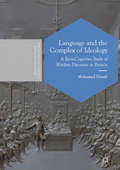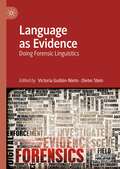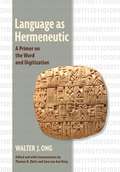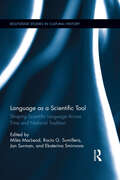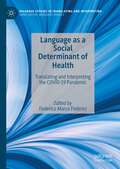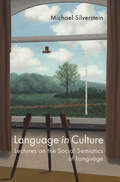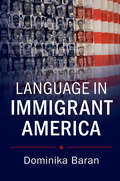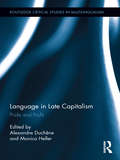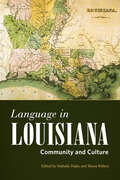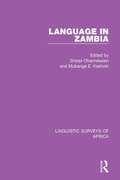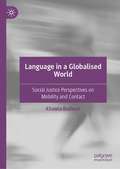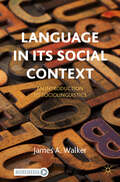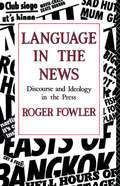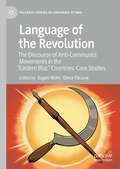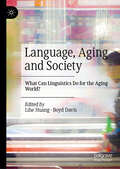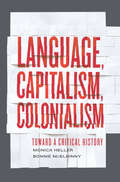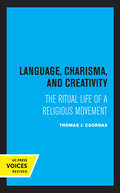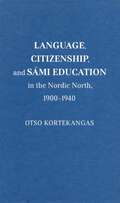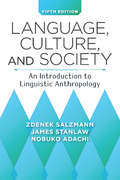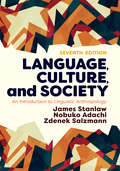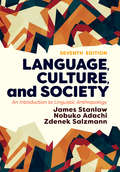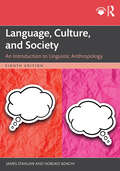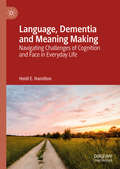- Table View
- List View
Language and the African American Child
by Lisa J. Green"How do children acquire African American English? How do they develop the specific language patterns of their communities? Drawing on spontaneous speech samples and data from structured elicitation tasks, this book explains the developmental trends in the children's language. It examines topics such as the development of tense/aspect marking, negation and question formation, and addresses the link between intonational patterns and meaning. Lisa Green shows the impact that community input has on children's development of variation in the production of certain constructions such as possessive -s, third person singular verbal -s, and forms of copula and auxiliary be. She discusses the implications that the linguistic description has for practical applications, such as developing instructional materials for children in the early stages of their education"--
Language and the Complex of Ideology: A Socio-Cognitive Study of Warfare Discourse in Britain (Postdisciplinary Studies in Discourse)
by Mohamed DouifiThis book undertakes a systematic analysis of the workings of ideology in discourse, using an interdisciplinary approach that links language, cognition and society. Through examination of two corpora - a collection of British newspaper articles and a set of political speeches - the author examines Britain's involvement in the Iraq War (2003), and critically assesses the language practices which constructed a pro-war ideology under Tony Blair's premiership. Drawing on a constellation of concepts from van Dijk's socio-cognitive model, this book carries out both qualitative and quantitative analyses and conceptualises discourse as a nonlinear, highly discursive and socio-cognitive phenomenon. This innovative work will appeal to students and scholars of Cognitive Linguistics, Quantitative Linguistics, Social Constructivism, Critical Discourse Analysis, Political Sciences and Communication Studies.
Language and the Law
by Douglas A. KibbeeLanguage policy is a topic of growing importance around the world, as issues such as the recognition of linguistic diversity, the establishment of official languages, the status of languages in educational systems, the status of heritage and minority languages, and speakers' legal rights have come increasingly to the forefront. One fifth of the American population do not speak English as their first language. While race, gender and religious discrimination are recognized as illegal, the US does not currently accord the same protections regarding language; discrimination on the basis of language is accepted, and even promoted, in the name of unity and efficiency. Setting language within the context of America's history, this book explores the diverse range of linguistic inequalities, covering voting, criminal and civil justice, education, government and public services, and the workplace, and considers how linguistic differences challenge our fundamental ideals of democracy, justice and fairness.
Language as Evidence: Doing Forensic Linguistics
by Dieter Stein Victoria Guillén-NietoThis edited book provides a comprehensive survey of the modern state of the art in forensic linguistics. Part I of the book focuses on the role of the linguist as an expert witness in common law and civil law jurisdictions, the relation of expert witnesses and lawyers, ethics standards, and courtroom interaction. Part II deals with some of the major areas of expertise of forensic linguistics as the scientific study of language as evidence, namely authorship identification, speaker identification, text authentication, deception and lie detection, plagiarism detection, and cyber language crimes. This book is intended to be used as a reference for academics, students and practitioners of Linguistics, Forensic Linguistics, Law, Criminology, and Forensic Psychology, among other disciplines.
Language as Hermeneutic: A Primer on the Word and Digitization
by Walter J. OngLanguage in all its modes—oral, written, print, electronic—claims the central role in Walter J. Ong’s acclaimed speculations on human culture. After his death, his archives were found to contain unpublished drafts of a final book manuscript that Ong envisioned as a distillation of his life’s work. This first publication of Language as Hermeneutic, reconstructed from Ong’s various drafts by Thomas D. Zlatic and Sara van den Berg, is more than a summation of his thinking. It develops new arguments around issues of cognition, interpretation, and language. Digitization, he writes, is inherent in all forms of "writing," from its early beginnings in clay tablets. As digitization increases in print and now electronic culture, there is a corresponding need to counter the fractioning of digitization with the unitive attempts of hermeneutics, particularly hermeneutics that are modeled on oral rather than written paradigms.In addition to the edited text of Language as Hermeneutic, this volume includes essays on the reconstruction of Ong’s work and its significance within Ong’s intellectual project, as well as a previously unpublished article by Ong, "Time, Digitization, and Dalí's Memory," which further explores language’s role in preserving and enhancing our humanity in the digital age.
Language as a Scientific Tool: Shaping Scientific Language Across Time and National Traditions (Routledge Studies in Cultural History)
by Miles MacLeod, Rocío G. Sumillera, Jan Surman and Ekaterina SmirnovaLanguage is the most essential medium of scientific activity. Many historians, sociologists and science studies scholars have investigated scientific language for this reason, but only few have examined those cases where language itself has become an object of scientific discussion. Over the centuries scientists have sought to control, refine and engineer language for various epistemological, communicative and nationalistic purposes. This book seeks to explore cases in the history of science in which questions or concerns with language have bubbled to the surface in scientific discourse. This opens a window into the particular ways in which scientists have conceived of and construed language as the central medium of their activity across different cultural contexts and places, and the clashes and tensions that have manifested their many attempts to engineer it to both preserve and enrich its function. The subject of language draws out many topics that have mostly been neglected in the history of science, such as the connection between the emergence of national languages and the development of science within national settings, and allows us to connect together historical episodes from many understudied cultural and linguistic venues such as Eastern European and medieval Hebrew science.
Language as a Social Determinant of Health: Translating and Interpreting the COVID-19 Pandemic (Palgrave Studies in Translating and Interpreting)
by Federico Marco FedericiThis edited volume demonstrates the fundamental role translation and interpreting play in multilingual crises. During the COVID-19 pandemic, limited language proficiency of the main language(s) in which information is disseminated exposed people to additional risks, and the contributors analyse risk communication plans and strategies used throughout the world to communicate measures through translation and interpreting. They show that a political willingness to understand the role of language in public health could lead local and national measures to success, sampling approaches from across four continents. The book will be of interest to students and scholars of healthcare translation and interpreting, sociolinguistics and crisis communication, as well as practitioners of risk and crisis communication and professional translators and interpreters.
Language in Culture: Lectures on the Social Semiotics of Language
by Michael SilversteinLanguage enables us to represent our world, rendering salient the identities, groups, and categories that constitute social life. Michael Silverstein (1945–2020) was at the forefront of the study of language in culture, and this book unifies a lifetime of his conceptual innovations in a set of seminal lectures. Focusing not just on what people say but how we say it, Silverstein shows how discourse unfolds in interaction. At the same time, he reveals that discourse far exceeds discrete events, stabilizing and transforming societies, politics, and markets through chains of activity. Presenting his magisterial theoretical vision in engaging prose, Silverstein unpacks technical terms through myriad examples – from brilliant readings of Marcel Marceau's pantomime, the class-laced banter of graduate students, and the poetics/politics of wine-tasting, to Fijian gossip and US courtroom talk. He draws on forebears in linguistics and anthropology while offering his distinctive semiotic approach, redefining how we think about language and culture.
Language in Immigrant America
by Dominika BaranExploring the complex relationship between language and immigration in the United States, this timely book challenges mainstream, historically established assumptions about American citizenship and identity. Set within both a historical and a current political context, this book covers hotly debated topics such as language and ethnicity, the relationship between non-native English and American identity, perceptions and stereotypes related to foreign accents, code-switching, hybrid language forms such as Spanglish, language and the family, and the future of language in America. Work from the fields of linguistics, education policy, history, sociology, and politics are brought together to provide an accessible overview of the key issues. Through specific examples and case studies, immigrant America is presented as a diverse, multilingual, and multidimensional space in which identities are often hybridized and always multifaceted.
Language in Late Capitalism: Pride and Profit (Routledge Critical Studies in Multilingualism)
by Alexandre Duchêne Monica HellerThis book examines the ways in which our ideas about language and identity which used to be framed in national and political terms as a matter of rights and citizenship are increasingly recast in economic terms as a matter of added value. It argues that this discursive shift is connected to specific characteristics of the globalized new economy in what can be thought of as "late capitalism". Through ten ethnographic case studies, it demonstrates the complex ways in which older nationalist ideologies which invest language with value as a source of pride get bound up with newer neoliberal ideologies which invest language with value as a source of profit. The complex interaction between these modes of mobilizing linguistic resources challenges some of our ideas about globalization, hinting that we are in a period of intensification of modernity, in which the limits of the nation-State are stretched, but not (yet) undone. At the same time, this book argues, this intensification also calls into question modernist ways of looking at language and identity, requiring a more serious engagement with capitalism and how it constitutes symbolic (including linguistic) as well as material markets.
Language in Louisiana: Community and Culture (America's Third Coast Series)
by Nathalie Dajko and Shana WaltonContributions by Lisa Abney, Patricia Anderson, Albert Camp, Katie Carmichael, Christina Schoux Casey, Nathalie Dajko, Jeffery U. Darensbourg, Dorian Dorado, Connie Eble, Daniel W. Hieber, David Kaufman, Geoffrey Kimball, Thomas A. Klingler, Bertney Langley, Linda Langley, Shane Lief, Tamara Lindner, Judith M. Maxwell, Rafael Orozco, Allison Truitt, Shana Walton, and Robin WhiteLouisiana is often presented as a bastion of French culture and language in an otherwise English environment. The continued presence of French in south Louisiana and the struggle against the language's demise have given the state an aura of exoticism and at the same time have strained serious focus on that language. Historically, however, the state has always boasted a multicultural, polyglot population. From the scores of indigenous languages used at the time of European contact to the importation of African and European languages during the colonial period to the modern invasion of English and the arrival of new immigrant populations, Louisiana has had and continues to enjoy a rich linguistic palate. Language in Louisiana: Community and Culture brings together for the first time work by scholars and community activists, all experts on the cutting edge of research. In sixteen chapters, the authors present the state of languages and of linguistic research on topics such as indigenous language documentation and revival; variation in, attitudes toward, and educational opportunities in Louisiana’s French varieties; current research on rural and urban dialects of English, both in south Louisiana and in the long-neglected northern parishes; and the struggles more recent immigrants face to use their heritage languages and deal with language-based regulations in public venues. This volume will be of value to both scholars and general readers interested in a comprehensive view of Louisiana’s linguistic landscape.
Language in Zambia (Linguistic Surveys of Africa #6)
by Sirarpi Ohannessian Mubanga E. KashokiOriginally published in 1978, this volume is divided into 3 parts. Part 1 presents an overview of the linguistic situation in Zambia: who speaks which languages, where they are spoken, what these languages are like. Special emphasis is given to the extensive survey of the languages of the Kafue basin, where extensive changes and relocations have taken place. Part 2 is on language use: patterns of competence and of extension for certain languages in urban settings, configurations of comprehension across language boundaries, how selected groups of multilinguals employ each of their languages and for what purposes, what languages are used in radio and television broadcasting and how decisions to use or not use a language are made. Part 3 involves language and formal education: what languages, Zambian and foreign, are used at various levels int he schools, which are taught, with what curricula, methods, how teachers are trained, how issues such as adult literacy are approached and with what success.
Language in a Globalised World: Social Justice Perspectives on Mobility and Contact
by Khawla BadwanThis book takes a critical look at the role of language in an increasingly diversified and globalised world, using the new framework of 'sociolinguistics of globalisation' to draw together research from human geography, sociolinguistics, and intercultural communication. It argues that globalisation has resulted in a destabilisation of social and linguistic norms, and presents a ‘language-in-motion’ approach which addresses the inequalities and new social divisions brought by the unprecedented levels of population mobility. This book looks at language on the individual, national and transnational level, and it will be of interest to readers with backgrounds in history, politics, human geography, sociolinguistics and minority languages.
Language in its Social Context: An Introduction to Sociolinguistics
by James A. WalkerThis textbook provides an accessible overview of the field of sociolinguistics. Blending qualitative and quantitative approaches and including examples drawn from different contexts and societies all over the world, the author introduces progressively complicated topics to help students build their confidence and understanding gradually as they work through the book. The chapters cover all the core topics on an introductory sociolinguistics course, including language and power, dialects, language and gender, language planning and multilingualism, and each chapter ends with a set of exercises, suggestions for small-scale projects which the author has used successfully with his own students and suggested further readings (both classic and more recent). This book assumes no background in Linguistics and is intended as an introduction to sociolinguistics that can be used at any level of undergraduate or graduate study, or by interested outsiders to the field.
Language in the News: Discourse and Ideology in the Press
by Roger FowlerLanguage in the News: Discourse and Ideology in the Press by Roger Fowler
Language of the Revolution: The Discourse of Anti-Communist Movements in the “Eastern Bloc” Countries: Case Studies (Palgrave Studies in Languages at War)
by Eugen Wohl Elena PăcurarThis edited book fills a void in the existing research concerning anti-communist movements in Central and Eastern Europe, outlining the linguistic implications of the cultural, social and political metamorphoses brought about by the (change of) regime. The authors included in this volume approach the topic from a variety of perspectives, but, ultimately, focus on language seen as a fundamental tool for simultaneously subjugating and liberating, concealing and revealing truth, discouraging dissidence and fostering revolt. Readers are invited to discover the linguistic implications of the many shapes and forms that the 1989 anti-communist revolutions took. Equally interesting are the investigations of the revolution aftermath, in the first years of transition to democracy. Perceived as a whole throughout the Cold War (1947-1991), the so-called "Eastern Bloc" managed to reveal its heterogeneity, the singularity of each of its comprising states and the multitude of its internal contrasts, most vividly perhaps, in the manifold manifestations of the 1989 anti-communist fight. This book will be of interest to academics and researchers from various fields, including history, (socio)linguistics, political studies, and conflict studies.
Language, Aging and Society: What Can Linguistics Do for the Aging World?
by Lihe Huang Boyd DavisThis book explores how studies of language and aging can be applied to build an aging-friendly society, drawing on the socio-pragmatic turn in language and aging to examine the perspectives of older adults experiencing aging through a linguistic lens. Research on the phenomenon and mechanisms of language in aging can provide older adults with language training, increase their active aging, and offer improved information communication channels for an aging society, which will bring a series of clinical and social benefits to handle problems in aging and language across the world. This book will be of interest to researchers in linguistics, sociology, gerontology and related fields.
Language, Capitalism, Colonialism: Toward a Critical History
by Monica Heller Bonnie McElhinnyHeller and McElhinny reinterpret sociolinguistics for the twenty-first century with an original approach to the study of language that is situated in the political and economic contexts of colonialism and capitalism. In the process, they map out a critical history of how language serves, and has served, as a terrain for producing and reproducing social inequalities. The authors ask how, and by whom, ideas about language get unevenly shaped, offering new perspectives that will excite readers and incite further research for years to come.
Language, Charisma, and Creativity: The Ritual Life of a Religious Movement
by Thomas J. CsordasThis title is part of UC Press's Voices Revived program, which commemorates University of California Press’s mission to seek out and cultivate the brightest minds and give them voice, reach, and impact. Drawing on a backlist dating to 1893, Voices Revived makes high-quality, peer-reviewed scholarship accessible once again using print-on-demand technology. This title was originally published in 1997.
Language, Citizenship, and Sámi Education in the Nordic North, 1900-1940 (McGill-Queen's Indigenous and Northern Studies)
by Otso KortekangasIn the making of the modern Nordic states in the first half of the twentieth century, elementary education was paramount in creating a notion of citizenship that was universal and equal for all citizens. Yet these elementary education policies ignored, in most cases, the language, culture, wishes, and needs of minorities such as the indigenous Sámi.Presenting the Sámi as an active, transnational population in early twentieth-century northern Europe, Otso Kortekangas examines how educational policies affected the Sámi people residing in the northern parts of Norway, Sweden, and Finland. In this detailed study, Kortekangas explores what the arguments were for the lack of Sámi language in schools, how Sámi teachers have promoted the use of their mother tongue within the school systems, and how the history of the Sámi compares to other indigenous and minority populations globally.Timely in its focus on educational policies in multiethnic societies, and ambitious in its scope, the book provides essential information for educators, policy-makers, and academics, as well as anyone interested in the history of education, and the relationship between large-scale government policies and indigenous peoples.
Language, Culture, and Society
by Zdenek Salzmann James Stanlaw Nobuko AdachiFor four previous editions, professors have turned to Zdenek Salzmann's Language, Culture, and Society for its comprehensive coverage of all critical aspects of linguistic anthropology, as well as for its student-friendly pedagogy. New coauthors James Stanlaw and Nobuko Adachi join Salzmann in revising this classic text. With extensive updates and expanded discussions of fundamental issues in the field, the fifth edition continues to be the essential teaching text for the introductory linguistic anthropology course.The fifth edition features three new chapters on language and thought, language and ideology, and language in a globalized world, as well as expanded consideration of the role of linguistics as a key subfield of anthropology. This edition also includes an updated built-in resource manual and study guide, including key terms, discussion questions, projects, objective study questions, and suggestions for further reading.
Language, Culture, and Society: An Introduction to Linguistic Anthropology
by Zdenek Salzmann James Stanlaw Nobuko AdachiWhy should we study language? How do the ways in which we communicate define our identities? And how is this all changing in the digital world? Since 1993, many have turned to Language, Culture, and Society for answers to questions like those above because of its comprehensive coverage of all critical aspects of linguistic anthropology. This seventh edition carries on the legacy while addressing some of the newer pressing and exciting challenges of the 21st century, such as issues of language and power, language ideology, and linguistic diasporas. Chapters on gender, race, and class also examine how language helps create-and is created by-identity. New to this edition are enhanced and updated pedagogical features, such as learning objectives, updated resources for continued learning, and the inclusion of a glossary. There is also an expanded discussion of communication online and of social media outlets and how that universe is changing how we interact. The discussion on race and ethnicity has also been expanded to include Latin- and Asian-American English vernacular.
Language, Culture, and Society: An Introduction to Linguistic Anthropology
by James StanlawWhy should we study language? How do the ways inwhich we communicate define our identities? And how is this all changing in thedigital world? Since 1993, many have turned to Language, Culture, and Society for answers toquestions like those above because of its comprehensive coverage of allcritical aspects of linguistic anthropology. This seventh edition carries onthe legacy while addressing some of the newer pressing and exciting challengesof the 21st century, such as issues of language and power, languageideology, and linguistic diasporas. Chapters on gender, race, and class alsoexamine how language helps create-and is created by-identity.New to this edition are enhanced and updated pedagogical features, such aslearning objectives, updated resources for continued learning, and theinclusion of a glossary. There is also an expanded discussion of communicationonline and of social media outlets and how that universe is changing how weinteract. The discussion on race and ethnicity has also been expanded toinclude Latin- and Asian-American English vernacular.
Language, Culture, and Society: An Introduction to Linguistic Anthropology
by James Stanlaw Nobuko AdachiWhy should we study language? How do the ways in which we communicate define our identities? And how is this all changing in the digital world? Over seven editions, many have turned to Language, Culture, and Society for answers to questions like these because of its comprehensive coverage of all critical aspects of linguistic anthropology. This eighth edition carries on the legacy while addressing some of the newer, pressing, and exciting challenges of the twenty-first century, such as issues of language and power, language ideology, linguistic diasporas, as well as online and digital ecosystems. New to this edition are a reconceptualization of how linguistics approaches race, gender, and sexuality, with additional chapters and sections on how linguistics benefits archaeology and biological anthropology, as well as considerations of the relationship between language and truth, ethics, and war and politics. It also features enhanced and updated pedagogical features, such as learning objectives, updated resources for continued learning, and cross-references to updated encyclopedias of linguistic anthropology.
Language, Dementia and Meaning Making: Navigating Challenges of Cognition and Face in Everyday Life
by Heidi E. HamiltonThis book investigates the ways in which context shapes how cognitive challenges and strengths are navigated and how these actions impact the self-esteem of individuals with dementia and their conversational partners. The author examines both the language used and face maintenance in everyday social interaction through the lens of epistemic discourse analysis. In doing so, this work reveals how changes in cognition may impact the faces of these individuals, leading some to feel ashamed, anxious, or angry, others to feel patronized, infantilized, or overly dependent, and still others to feel threatened in both ways. It further examines how discursive choices made by healthy interactional partners can minimize or exacerbate these feelings. This path-breaking work will provide important insights for students and scholars of sociolinguistics, applied linguistics, medical anthropology, and health communication.

